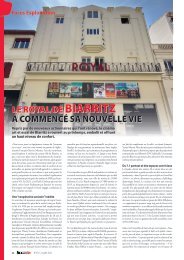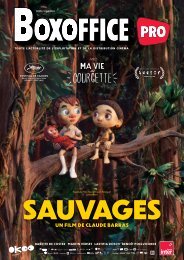Boxoffice Pro - Winter 2020
Boxoffice Pro is the official publication of the National Association of Theatre Owners
Boxoffice Pro is the official publication of the National Association of Theatre Owners
Create successful ePaper yourself
Turn your PDF publications into a flip-book with our unique Google optimized e-Paper software.
“Home video is actually a<br />
blessing to exhibitors, because<br />
it’s tapped into the people<br />
who are not contributing to<br />
Hollywood film production.”<br />
—Dan Harkins, 1985<br />
MTV-like model to put movie marketing<br />
(including trailers and interviews)<br />
into thousands of homes. Video was<br />
also presented as a medium to attract<br />
audiences who did not go to the movies<br />
at all. “Home video is actually a blessing<br />
to exhibitors, because it’s tapped into<br />
the people who are not contributing to<br />
Hollywood film production,” explained<br />
Dan Harkins in October 1985. A<br />
businessman in the videocassette field<br />
went even further in a 1981 article:<br />
“[Exhibitors] possess a knowledge that no<br />
other group of businessmen have in this<br />
country. They know motion pictures and<br />
how to sell them. It follows that they are<br />
the best-prepared group to become video<br />
cassette and disc retailers.” Auerbach<br />
agreed in a 1984 editorial, stating that “the<br />
rental business is a bit different from the<br />
usual snack bar activity, but hardly an<br />
overwhelming challenge to the theater<br />
employee.” Indeed, a few small theaters<br />
presented in the magazine, like Fred<br />
Kaysbier’s theater in Ogallala, Nebraska,<br />
or the Village Theater in Knoxville, Iowa,<br />
turned to video sales.<br />
The Window Issue<br />
What also concerned exhibitors was the<br />
matter of theatrical exclusivity windows.<br />
Talks about windows went back to the<br />
birth of TV, but the ’80s was the decade<br />
that saw the issue become much more<br />
prevalent in the magazine’s coverage. The<br />
editorial line was clear. “Exhibition must<br />
battle to preserve its place as the first-run<br />
outlet for product from Hollywood,” wrote<br />
Auerbach in November 1980, following<br />
an unofficial NATO convention in New<br />
Orleans dedicated to the topic. Auerbach<br />
was especially concerned by the evershrinking<br />
window between theatrical<br />
releases and cassette releases, noting that<br />
some videocassettes were released while<br />
films were still in theaters. That was not<br />
only true for smaller films but for bigger<br />
box office successes like Purple Rain,<br />
which became available on tape only six<br />
months after its initial theatrical release.<br />
“What became of the unwritten rule<br />
of a one-year window (now ostensibly<br />
six months but, in reality, four-orless<br />
months) on film to videotape<br />
transfers?” asked editor Harley W.<br />
Lond in December 1984. He noted that<br />
distributors, benefiting from word of<br />
mouth from theatrical releases, were<br />
eager to shorten the windows further.<br />
Subsequent-run theaters were hit the<br />
hardest. Auerbach wrote, in May 1984,<br />
that “a reasonable ‘window’ between<br />
theatrical and cassette release would at<br />
least help the first-run houses, although<br />
sub-run theaters would still have a<br />
tougher row to hoe.” The observation was<br />
echoed by George Kerasotes, president of<br />
Kerasotes Theaters, who in 1981 declared,<br />
<strong>Winter</strong> <strong>2020</strong><br />
33

















